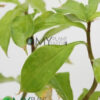- Empty cart.
- Continue Shopping
“Vicks Plant”: Hidden Wonders, Benefits, Care Tips, and Fun Facts
Introduction: Welcome to our blog, where we delve into the fascinating world of plants! In this edition, we’ll be exploring a unique and extraordinary plant—the Vicks plant (Plectranthus tomentosa). Not only does it possess a delightful aroma reminiscent of the famous Vicks VapoRub, but it also boasts an array of benefits for our well-being. Join us as we uncover the remarkable attributes, care tips, and intriguing facts surrounding this captivating herb.
- Aromatic Therapy: The Vicks plant owes its name to the unmistakable scent that its leaves emit, evoking memories of the comforting and soothing properties of Vicks VapoRub. The fragrance comes from the essential oils present in the plant, which contain compounds like camphor and menthol. These natural aromatics have been used for centuries in various traditional medicines to help alleviate respiratory conditions, headaches, and muscle discomfort.
- Air Purification: Aside from its therapeutic aroma, the Vicks plant acts as a natural air purifier. It has the ability to filter out harmful toxins from the air, including formaldehyde and benzene, which can be found in common household products. By placing a Vicks plant in your living space, you can enjoy cleaner and fresher indoor air.
- Easy Care Tips: Caring for the Vicks plant is relatively simple, making it an ideal choice for both experienced and novice gardeners. Here are some essential care tips to ensure your plant thrives:a. Lighting: The Vicks plant thrives in bright, indirect light. Place it near a window where it can receive a few hours of sunlight each day. However, avoid exposing it to direct sunlight, as it can scorch the leaves.b. Watering: Keep the soil evenly moist, but not soggy. Water the plant when the top inch of soil feels dry to the touch. Overwatering can lead to root rot, so be cautious not to let the plant sit in standing water.c. Humidity: The Vicks plant appreciates higher humidity levels. You can increase humidity by misting the leaves regularly or placing a tray of water near the plant to create a humid microclimate.d. Temperature: Maintain a temperature range of 60-75°F (15-24°C) for optimal growth. Avoid exposing the plant to cold drafts or extreme temperature fluctuations.e. Pruning: To encourage bushier growth, regularly pinch back the tips of the Vicks plant. This will promote branching and create a fuller appearance.
- Fun Facts: The Vicks plant has a few intriguing characteristics that make it even more captivating:a. Origin: The Vicks plant is native to southern Africa, particularly the regions of Zimbabwe and South Africa. It thrives in warm climates and is often cultivated as a houseplant in cooler regions.b. Furry Leaves: One of the distinct features of the Vicks plant is its soft and fuzzy leaves. This unique texture adds to its appeal and makes it an intriguing addition to any plant collection.c. Insect Repellent: The aromatic compounds in the Vicks plant also act as a natural insect repellent. Placing it near doorways or windows can help deter unwanted pests from entering your home.d. Medicinal Traditions: Throughout history, the leaves of the Vicks plant have been used in traditional medicine to alleviate coughs, colds, and congestion. Its therapeutic properties have made it a popular choice for herbal remedies.
Conclusion: Incorporating the Vicks plant into your indoor garden not only adds a touch of natural beauty but also





